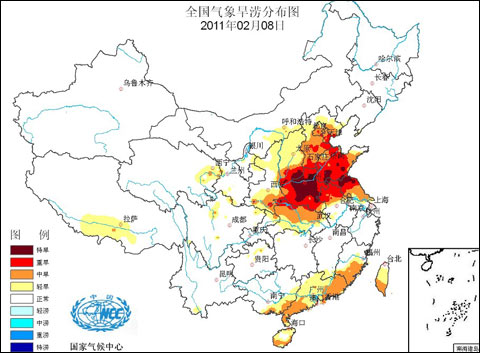The Central Meteorological Observatory predicts that in the meteorological arid regions such as North China and Huanghuai, there will be two weak precipitation events on 12-13 and 15-16, which will benefit some areas of Beijing, Tianjin, Henan, Shanxi, Hebei and Shandong. Increasing the number of people will play a certain role in easing the drought. The meteorological department will closely monitor the occurrence and development of precipitation in the dry areas, timely release warning service information, and carry out artificial precipitation (snow) operations in due course.
Precipitation occurred in the arid areas of North China and Huanghuai, and the drought in some areas has eased.

Precipitation map of meteorological arid regions in North China and Huanghuai (February 10, 2011, 14:00 to 10:00 pm)
Following the obvious rain and snow in the meteorological arid regions of North China and Huanghuai on the 9th, snowfall occurred in the meteorological arid areas yesterday. According to the latest meteorological data, from 0:00 on the 9th to the present day, there were 1-4 mm snowfall in the meteorological arid regions such as North China, Huanghuai Central and Jianghuai, northwest and south, central Hebei, Beijing, central and southern Henan, and Shandong. Some areas in the southwest and other parts of Anhui and most of Anhui, most of Jiangsu snowfall 6-15 mm, local 20-25 mm.


National Meteorological Drought and Flood Distribution Map (on: February 8th, next: February 10th, red is heavier, indicating greater drought)
Since October 2010, precipitation in the winter wheat area in the north has been decreasing. Some areas such as Shandong and Hebei have not had effective precipitation for more than three consecutive months. Hebei, Shanxi, Jiangsu, Anhui, Shandong, Henan, Shaanxi and Gansu provinces. Dry areas in some areas have emerged and continue to develop. According to the agricultural dispatch of the Ministry of Agriculture, as of February 4, the winter wheat in the eight provinces suffered a drought of 96.11 million mu, accounting for 35.1% of the winter wheat planting area of ​​the eight provinces, accounting for 21.7% of the cultivated land area of ​​the eight provinces. Accounted for more than 80% of the country.


Dynamic monitoring of soil moisture in winter wheat and arid regions of northern China (1: February 9th, next: February 10th)
The rain and snow on February 9-10 is very beneficial to increase the soil moisture in the above areas. After the rain and snow, the surface soil deficiency in southern Henan and central and northern Anhui was reduced, and the degree of defects was reduced. The soils in southern Henan and parts of western Anhui were relieved and reached a suitable state. At present, the rain and snow process has not completely ended. As the snow gradually melts and slowly infiltrates, the soil moisture in the above areas will be further supplemented and improved. However, the drought in the northwestern part of Henan Province and the severely deficient areas of northern Anhui Province has not been effectively alleviated; as of now, there is still no precipitation in the north-south Shandong Province where the drought is severe.
In the future, there are still two weak precipitations in North China and Huanghuai, and it is not suitable for irrigation in the northern winter wheat area.
Today, North China, Huanghuai and other places gradually snowed fine. However, according to the Central Meteorological Observatory, on the 12-13th and 15th-16th, the meteorological arid regions such as North China and Huanghuai will continue to greet two precipitation weather, accompanied by 4 to 5 winds, and the temperature will drop by 3~. 6 ° C. On the 11th to 13th, the average daily temperature in the winter wheat area north of the Huaihe River will fall below 3 °C, and the winter wheat and arid areas are not suitable for irrigation. The specific forecast is as follows:
On the 12th to 13th, some areas of Shanxi, Hebei, Shandong and other places have 1-3 mm of snowfall; some parts of Beijing, Tianjin and Henan have sporadic snow.
On the 15th to 16th, the weather in the dry areas turned cloudy, and there were sporadic snows in parts of northern Hebei and northwestern Shanxi. There are 1-3 mm precipitation in parts of northern Susie.
The rain and snow process that has taken turns this time will definitely help to alleviate the drought in some areas of the winter wheat area. Regarding the current irrigation areas in winter and arid areas, Mao Liuxi, director of the National Meteorological Center's Agricultural Meteorological Center, pointed out that from the temperature point of view, the wheat areas south of the Yellow River can be irrigated, and the Yellow River area should pay close attention to the weather forecast. When the average temperature reaches above 3 °C, irrigation can be carried out, or the minimum temperature at night is not lower than 0 °C, and irrigation can be carried out without causing freezing damage to the wheat seedlings.
The meteorological department will closely monitor the occurrence and development of precipitation in the dry areas, timely release warning service information, and carry out artificial precipitation (snow) operations in due course.
Reflective Webbing,High Polyester Reflective Webbing,Reflective Webbing Strap
Jinyang Industrial Corporation., Ltd. , http://www.dmreflectives.com